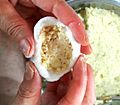Sweet bean paste facts for kids
Sweet bean paste is a popular ingredient used in many sweet treats across East Asia. Think of it like a yummy, thick spread made from beans! It's often used to fill delicious desserts and pastries.
Contents
How Sweet Bean Paste is Made
Making sweet bean paste starts with cooking beans. The beans are usually boiled until soft, but without adding any sugar. After boiling, they are mashed up and mixed with water to create a thick liquid called a slurry.
Next, this slurry is pushed through a sieve. This step helps to remove any tough bean skins or husks. The liquid that comes out is then filtered even more and squeezed to remove extra water. This makes the paste quite dry.
Finally, sugar is added to make it sweet! Sometimes, a little oil, like vegetable oil or even lard, is mixed in. This makes the paste smoother and gives it a better feel in your mouth.
You'll often find sweet bean paste with oil inside Chinese pastries. But if the paste doesn't have oil, it can be used to make sweet soups called tong sui. Many Japanese pastries, like wagashi, mostly use sweet bean pastes that don't have added oil.
Different Kinds of Sweet Bean Paste
There are several types of sweet bean paste, each made from different beans and with its own special look and taste:
- Oil bean paste (油豆沙) – This dark brown or black paste is made from azuki beans. It gets its dark color from added sugar, and sometimes animal fat or vegetable oil. It might even have a sweet flower flavor called Sweet Osmanthus.
- Mung bean paste (綠豆沙) – This paste is made from mung beans. It usually has a dull reddish-purple color.
- Red bean paste (紅豆沙) – Made from azuki beans, this paste is a deep red color. It's one of the most common types.
- White bean paste (白豆沙) – This paste is made from navy beans. It has a grayish off-white color.
- Black bean potato paste (黑豆沙) – This unique paste is made from black soybean powder and potatoes. It's often used in foods from Beijing and other parts of northern China.
Other Sweet Pastes
Besides bean pastes, there are other sweet pastes used in Chinese cooking. They are often used as fillings for desserts, just like bean pastes. Even though they aren't made from beans, they taste and feel very similar. These include:
- Lotus seed paste
- Black sesame paste
Gallery
-
Filling songpyeon (a Korean rice cake) with mung bean paste.
See also
 In Spanish: Pasta de judía dulce para niños
In Spanish: Pasta de judía dulce para niños





